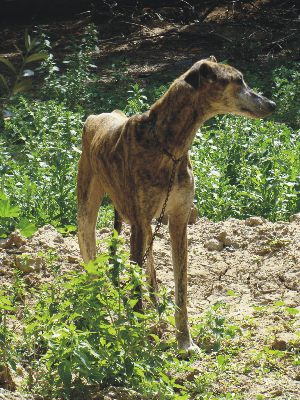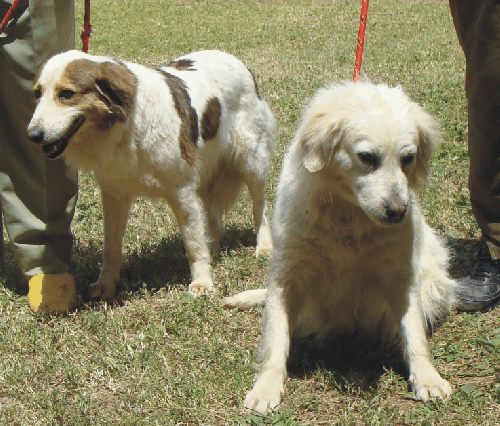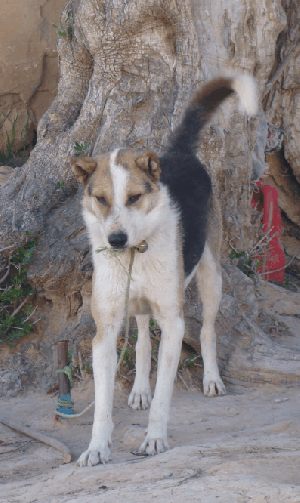

Genetics
   Left: Moroccan Sloughi; center: Moroccan Aidis; right: Tunisian village guard dog All Photos © de Caprona 2008 All photographs copyrighted to their photographers. Please do not use for any purpose without asking. Mitochondrial DNA of
Portuguese dogs
and their relationship to Sloughi, Aidi and Tunisian village dogs
For the first time, the study entitled "Mitochondrial DNA Sequence Variation in Portuguese Native Dog Breeds: Diversity and Phylogenetic Affinities" by A.E.Pires and collaborators (see references) analyses in depth the mitochondrial DNA (mtDNA) of the Portuguese native dogs and their relationships to geographically neighboring dog breeds in Spain and North Africa. Spain and the Maghreb region of North Africa (Morocco, Algeria, Tunisia) are neighbors to Portugal and included within the same zoogeographic region, the Mediterranean sub-region of the Paleartic. Historically, the Iberian Peninsula has had close contacts with North Africa, particularly when the Moors invaded this region and then occupied it for 8 centuries. The Moors introduced new crops and livestock, and they perhaps brought along their breeds of working dogs as well. Three populations of dog breeds from North Africa were therefore included in the study to describe and understand their genetic relationship with the Spanish and Portuguese dogs. A total of 13
populations
of dogs were included in the study. Haplotypes 49 mtDNA haplotypes (887 base pairs) were found in the 164 individuals studied, with private haplotypes found in several breeds.. Twelve of these haplotypes are shared by all 13 populations of dogs, the other 37 are specific to the breeds or dog populations in this study. The W1 Iberian wolf haplotype grouped with haplotypes from all breeds except Castro Laboreiro Watchdog, Portuguese Sheepdog, Aidi, and Portuguese Pointer. 11 haplotypes,
4 from
Aidi, 5 from Sloughi, and 2 from Tunisian dogs, were found only in
North
African dogs. With the exception of the Portuguese Warren hound, Aidi
and
Sloughi were the breeds showing the highest number of non-shared
haplotypes. One rare and geographically isolated breed, the Castro Laboreiro Watchdog, possessed a new haplotype and was monophorphic for it. It is considered by the authors to be the result of a severe bottleneck from a more diverse ancestor population of its own kind. The subtypes of the Portuguese Warren Hound (Podengo Português) could not be differentiated using mitochondrial DNA. Four of the major
clades
(A,B,C,D) found in other scientific studies on dogs were found here as
well, but new haplotypes were detected in Portugal and Morocco.
Regarding mtDNA,
Portuguese
village dogs showed no genetic differentiation from the native local
dog
breeds originated in areas in which the village dogs were sampled.
MtDNA Nucleotide diversity Except for the geographically restricted Castro Laboreiro Watchdog which shows no nucleotide diversity, this was on average high in the other breeds. The Estrela Mountain Dog, the Alentejo Shepherd dog, and the Spanish mastiff showed similar values of genetic diversity. High levels of nucleotide diversity were found in the Northern African dogs as well. Conclusion The genetic differentiation among the breeds and dog populations in this study was statistically significant. The authors state that conservation should take into account the uniqueness of genetic characters highlighted in their study, and that other nuclear makers would be very useful to accurately assess breed distinctiveness in the breeds with high mtDNA diversity. The 3 African domestic dog populations were found to have distinct haplotypes and distinct haplotype frequencies from Portuguese dogs. Even if some of the haplotypes were shared, and in spite of the fact that Moors occupied Iberia for 8 centuries, there is no evidence in this study which supports introgression or a South-North cline in frequency of haplotypes of North African dogs' haplotypes into Iberian dogs. This stands in contrast to what was found by other researchers for livestock. In other words, livestock imported to Iberia by the Moors have blended their mitochondrial DNA into the local livestock to various degrees, whereas no evidence shows that their working dogs did the same with the populations of dogs in this study. Finally, although they are sometimes found in the same environment, the Sloughi and the Aidi did not share their mtDNA extensively. Aknowledgements I thank A.E.Pires for fine tuning this text. References Pires A. E., L. Ouragh, M. Kalboussi, J. Matos, F. Petrucci-Fonseca, M. W. Bruford (2006): "Mitochondrial DNA Sequence Variation in Portuguese Native Dog Breeds: Diversity and Phylogenetic Affinities." Journal of Heredity 97:318-330 The Portuguese and Spanish breeds in the study
|